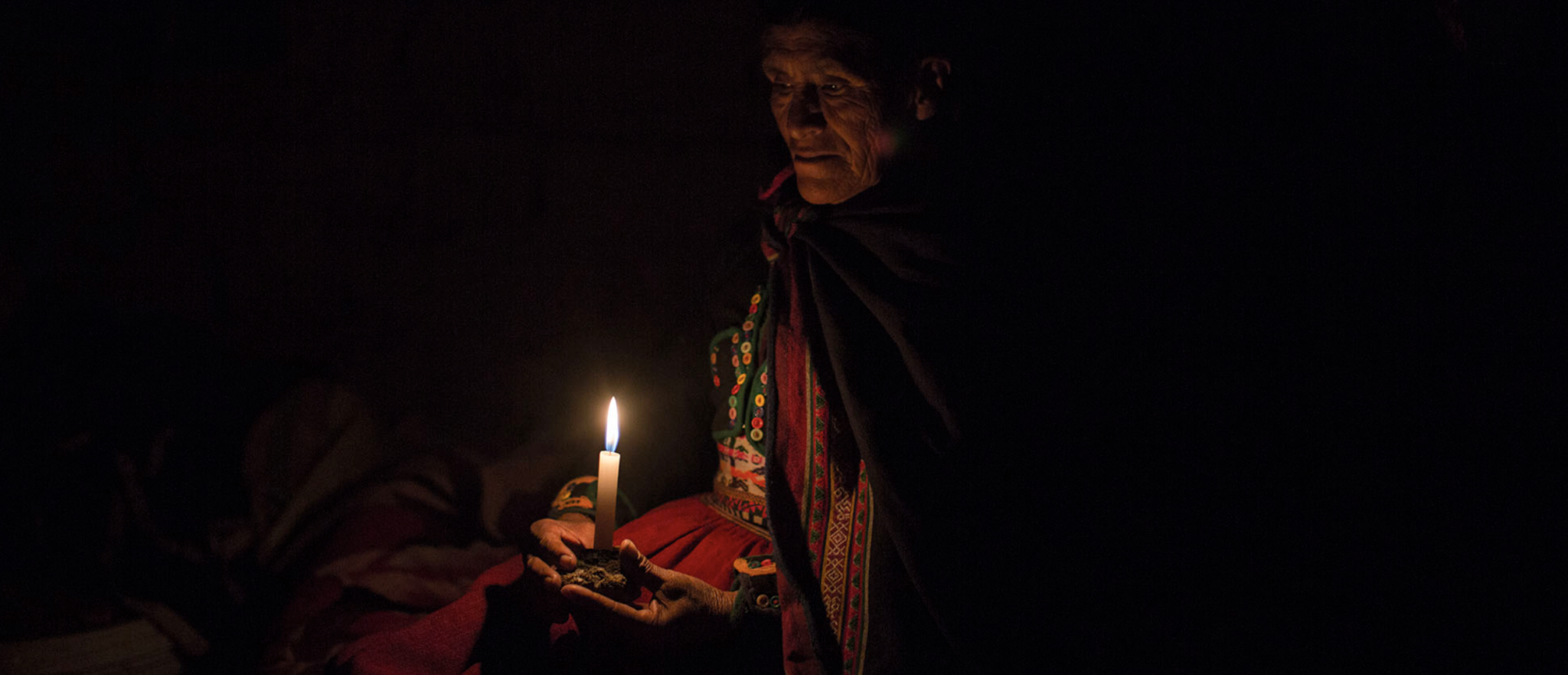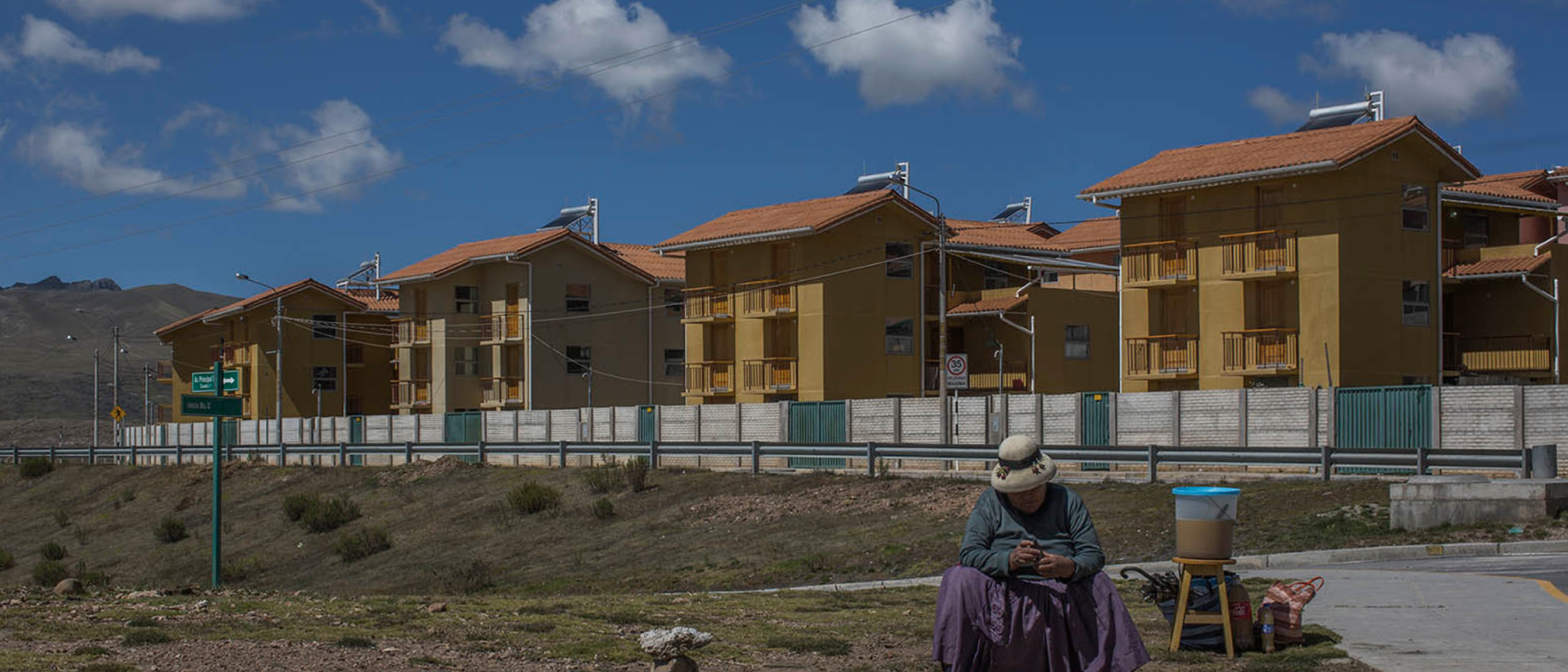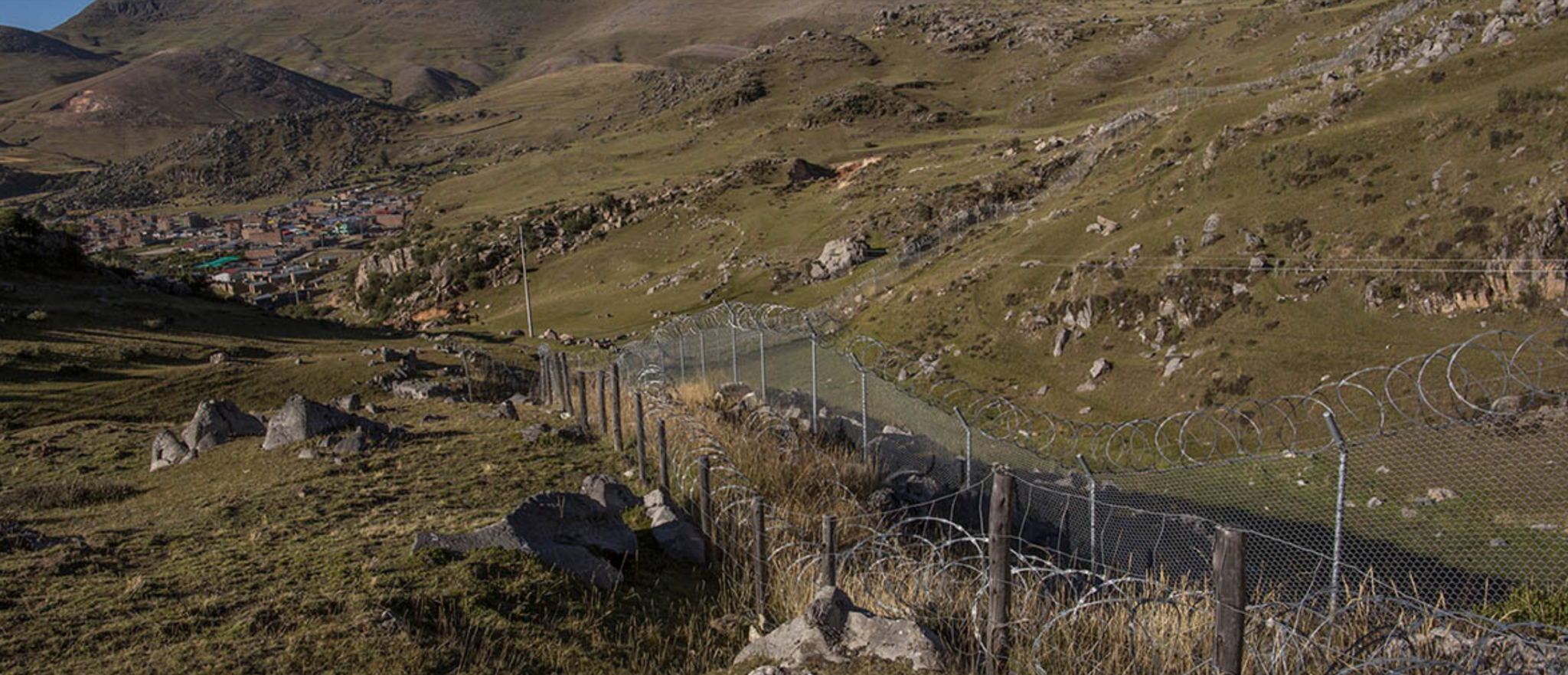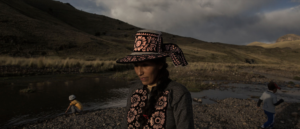Dozens of indigenous communities without water or electricity in the southern Andean region of Peru watch the wealth from mineral mining pass by their homes. With rights to water exploitation issued without proper assessments, inefficient public spending, loss of communal property, and violation of the right to prior consultation, they continue to be sceptical of mining projects like Las Bambas, owned by Chinese company MMG Limited.
“Who are you coming with?” asks Rogers Ccoropuna, president of the Chuicuni community.
Icy wind challenges the sun at 3,800 metres above sea level. It is harvest time in the Andes and the wheat fields shine brighter than ever on Ccoropuna’s farm, located in an indigenous community beside one of the largest mining projects in Peru: Las Bambas, operated by Chinese company MMG Limited, a subsidiary of China Minmetals.
“Who are you coming with?” He insists.
“It’s just us,” we reply.
“I don’t believe you. Most journalists come here on behalf of the mine.”
Mistrust has become a central part of coexisting in Chuicuni. The influence of Las Bambas extends across all the communities located in the district of Chalhuahuacho. The mine sponsors radio stations and their programmes. In restaurants, the diners are mineworkers. In hotels, the guests are consultants, engineers, or other company employees. It’s the same in the bars and nightclubs.
Chuicuni is located next to the mining project, ten minutes from Chalhuahuacho. But it has no electricity, no shops, and no houses taller than one storey. Residents capture water from a spring. It flows untreated through a pipe to a tank in the centre of town.
“Each villager has contributed between 10 and 15 soles (US$3-4.50) to cover the cost of this work. We did it on our own. Not the municipality. Not the government. Just us,” says Ccoropuna.
The people of Chuicuni have built everything by themselves. The only way to get here is across a pedestrian bridge over a river. They built it “without technical approval”, the community leader points out with some annoyance. “We do not really know how many people or how much weight it can bear.” But today, Ccoropuna’s main concern is not the bridge, but the water: What will happen if the spring that supplies the entire town dries up one day? What if the mining project affects the quality of water?
This area is known as the Southern mining corridor on account of the high concentration of projects here. Peru is the world’s second largest producer of copper, zinc, and silver. About 40% of national copper production happens here.
“We are sorry to be living here. There is no point living so close to a mine,” Ccoropuna laments.

Watching wealth from a house without water
Life in Chuicuni starts before five in the morning at a temperature of four degrees Celsius. From one of the hills, the mine’s trucks and tippers are visible. On the other side there is an enormous metal fence. The mesh divides communal land from MMG’s private property. The echo from the trucks breaks the silence. Down in the village, women get up to fetch water from the communal standpipe and prepare breakfast for their children, while some men take their cattle to graze.
From the hilltop, Javier Huillca Puma, Chuicuni’s vice president, points towards the boundaries of the community. “Our neighbouring community was Fuerabamba, and our cattle went from one place to another without a problem. We understood each other. That doesn’t happen now,” he says.
In 2004 the government of former President Alejandro Toledo granted exploration rights to Las Bambas and following the start of operations in 2014, Fuerabamba was relocated to an urban area around Chalhuahuacho that had basic public services. Chuicuni remained where it was, without water or electricity. It was in that state that the community welcomed its new mining neighbour.
Since then, the villagers have lived with noise, dust, and small tremors caused by explosions. The 200 families of this community also watched the mine install a plant to treat the water for its workers and huge cables over their homes to transmit power, while they remain in the dark.
Despite its proximity, Chuicuni is not considered within the mine’s area of direct influence. “The municipality tells us that we have to negotiate with the mine, and the company tells us that we must demand infrastructure from the municipality because we are within direct influence,” complains Ccoropuna.
The community president demands water and sanitation services. “We are afraid that the river’s flow will change and we will run out of water. Sometimes only a small amount of water comes out and we have to queue up so there will be enough for everyone,” he says.
Exploitation of metals at Las Bambas began in 2014. There is currently no evidence of its impact on water resources. Officials of the Local Water Authority acknowledged during a meeting with Ojo-Publico.com that there were no detailed water studies for the Apurímac basin when the water use rights for mining were issued, and when the Environmental Impact Study was approved.
The most up-to-date studies, the same officials say, were commissioned by the mining company itself as part of the procedure to request the mining water use license.
A 2016 watershed prioritisation study for water resource management established risk rankings of low, medium, high and very high-risk for the use and disposal of water. Ccoropuna isn’t aware of it, but this document rates the High Apurímac Interbasin, where the land of his community is located, as very high risk. The report assessed several risk factors: quality; pollution; availability; droughts; population size; poverty rates; exploitation of aquifers; population and poverty rates; conflicts over water; and the demand and supply of water.
In the four provinces of the Southern mining corridor alone, the government has granted 147 water exploitation rights for mining purposes. Of these, 40% are for extraction of groundwater, considered by experts to be a non-renewable resource.
The number of rights granted for agricultural and domestic purposes is much higher, but collection points for mining are in areas considered to be headwaters, locations that under current legislation are considered vulnerable.
The provision of rights to exploit clean water for mining has not been accompanied by public works that guarantee access to safe water for urban and indigenous populations near mining operations. A review of local and regional government budgets shows that more building construction and road maintenance has taken place than sanitation works.
Ccoropuna acknowledges that his community was initially enthusiastic about the mining project: “We were totally in favour of the mining company, thinking that it would have a positive impact. They said there would be a school, basic sanitation, and electricity. So we supported it. But we have nothing.”
The day in Chuicuni ends when the sun goes down. At home, 8-year-old Nadith, Ccoropuna’s niece, lights a candle with a match to read a book. Outside, there are only shadows.

Wealth contradictions
One of the first things they tell you to look out for when you get to Chalhuahuacho is the number of SUVs along its unpaved streets potted with puddles of water. The size of these vehicles, all expensive models, contrasts with the narrow labyrinthine roads. Farmers bought them with money for the sale of their land or the compensation they received from the Las Bambas mining project.
Chalhuahuacho is the richest district of the southern Andes. Its population of 7,000 people has one of the highest averages of trucks per person. Yet is has no potable water service and its waste is thrown into the river. The district has 38 Quechua indigenous communities and an estimated budget of US$41 million this year, an amount comparable to that enjoyed by Lima’s wealthiest districts. The municipal budget has grown almost 30 times in the past six years.
Chalhuahuacho seems to have been possessed by the same curse as other mining districts in Peru: billion-dollar budgets, poor execution of public works, stagnant social indicators and corruption. Mayor Antolín Chipana Lima is in prison and under investigation for money laundering and misappropriation of assets. Prior to his election in 2014, he was one of the most critical voices against mining. When he was detained this March, police found the equivalent of US$3,500 dollars in cash at his home. His general secretary, Dionisio Maldonado, who is also arrested, had US$14,900.
There is so much dust generated by cars, shared taxis and, above all, the dozens of giant trucks that transport tons of processed copper every day that cleaning the windows of cars, houses and shops in Chalhuahuacho is pointless.
There is another parade of vehicles inside the grounds of the Challhuahuacho Health Centre. These are broken or damaged. “They send us vehicles that are unsuitable for the area and that break down after a short time. They also donate vehicles that already obsolete,” explain a couple of health officials who preferred to remain unidentified.
The broken down vehicles are not the centre’s main problem. Biologist Hubert Firata says that anaemia and poor water quality threaten the health of Chalhuahuacho’s inhabitants and the dozens of indigenous communities located in the mine’s area of influence. “It is not safe. The water that reaches houses comes through pipes and only sometimes has the necessary doses of chlorine added,” he says.
A week before our visit, Hubert Firata analysed several samples. “To be safe it must contain 0.5 mg of chlorine per litre, but in the samples that we analysed from various sectors of Challhuahuacho, chlorine didn’t even reach 0.1 mg per litre. With that amount it is impossible to eliminate the water’s bacteriological load. The municipality should do the cleaning and chlorination but they do not,” he said.
Statistics from the Regional Health Directorate indicate that in 2017 chronic malnutrition had increased by 30% compared to 2016. “Even the medical personnel show signs of malnutrition and anaemia. However, the most serious cases have been found in pregnant women,” he says.
The increase in malnutrition and anaemia results from changes in eating habits. As in other areas impacted by extractive activities, investment boosts the local economy. There is more employment and trade. “Children and adults now eat more carbohydrates and processed foods. The consumption of local products is being abandoned,” says Firata. The health centre receives an average of thirty children each day.
As a remote rural facility, the centre does not offer all services. In an emergency, patients have to travel to Tambobamba, located an hour away. More serious cases mean a trip to Cusco of eight hours by car.
The lack of ambulances means only patients with financial resources can receive attention in specialised hospitals. A doctor at the health centre told the story of a child who had immersed her hand in boiling water. “Although she needs specialist care, she cannot travel to Cusco because her parents do not have money to pay for the transfer.”
Economic contrasts in this area are highly pronounced. While there is a lack of basic services in communities such as Chuicuni, a full range of services are available in Nueva Fuerabamba, the new site to which the community was relocated when huge copper deposits were discovered.
It is a huge residential complex consisting of 500 identical houses. Each has three floors, a family garden and a fence. The roads are paved. There is electricity, water, and permanent sanitation. The school has all the services and there is a fully equipped health centre. Many community members who live here are traders.

Land rights and mining
More than half of the Quechua indigenous communities in the area do not have their community land boundaries properly geo-referenced. Most of these lack official titles and are not recorded by the Public Registry. It was under these circumstances that between 2012 and 2015 many mining projects in this part of the southern mining corridor were approved.
In this same context, there was discussion of a database of indigenous communities, which would oblige the state to consult with them on projects prior to their implementation.
As a previous investigation by Ojo-Publico.com has revealed, during this period the government of Ollanta Humala gained access to a preliminary database identifying Quechua indigenous communities in the southern mining corridor but decided not to publish it. The complete list only became known in 2016, when several mining investments were already underway.
Between the provinces of Cotabambas and Antabamba, both in Apurímac, the Ministry of Culture’s Indigenous Peoples Database identified twenty-six indigenous communities. Patahuasi was one of them. It is also one of the oldest communities in the region, having been recognised in 1928. Until last year, however, the coordinates of the boundaries of its communal lands were not registered and had not been geo-referenced. Some 61% of its 500 families live in extreme poverty. 99% speak Quechua.
There was never any prior consultation in Patahuasi and nor was there any in Chuicuni, even though the latter appeared in the preliminary database of indigenous peoples to which the government had access when it approved operations at Las Bambas. Chuicuni did not appear on the 2016 release of the final list of indigenous communities entitled to prior consultation. Ccoropuna is unaware of the community’s past or current status on the list.
Why did they appear previously but not now? Who counts as indigenous in Peru? The Andes is home to more than 70% of the entire indigenous population of the country. In the preliminary database that was filtered and later disseminated by Ojo-Publico.com in 2015 some 436 indigenous Quechua communities were registered in Apurímac. However, only 279 appear on the current list administered by the government.
The community of Chuicuni is recorded in the Public Registry, but its communal boundaries are not properly geo-referenced and registered. The community was recognised in 1986 and now has 854 hectares of land. The state’s argument for not undertaking prior consultation in the indigenous communities near Las Bambas was that the database was not known and the geographical boundaries were unclear.

Ccoropuna explains that people in his community have been unable to geo-reference their boundaries until now because preparing the technical reports requires a big budget. “We do not have the money to do all this,” he says. What little money the community manages to raise has been used to build vital infrastructure to upgrade the improvised network of pipes that carries the water from the spring to the heart of the town.
Communities located in the Las Bambas area were not consulted about the modification of the Environmental Impact Study, which replaced the installation of an underground pipeline for the transfer of minerals (an ore pipeline) with a proposal to use a highway for the transport. “We were never made aware,” says Ccoropuna.
Until 2014, Las Bambas was owned by Glencore Xtrata, the Swiss mining giant. That year the company sold the project to a consortium of Chinese companies led by MMG Limited, a subsidiary of China Minmetals. At the beginning of the mining operations, the community of Chuicuni, like others in the area, approved of the mining project. “Many of us supported the project because we thought we were going to have a job. [Glencore Xtrata] offered us everything. Now when we complain they tell us that those deals were made by the previous owner,” says Ccoropuna.
Javier Huillca, Vice President of the community of Chuicuni, says that when Glencore Xtrata owned Las Bambas the company committed to pay a sum for using its territory for the mineral pipeline. However, with changes to the impact study, and the replacement of the pipeline by the highway, Chuicuni was left without compensation.
With few new opportunities for the community created by the mine, even traditional sources of revenue are drying up. Sales of trout at the Sunday markets in Haquira and Patahuasi are down. “They are afraid it’s contaminated,” Huillca says.
This story featured in Ojo Publico’s special investigative project ‘The water bosses‘. The story is republished here with permission.
